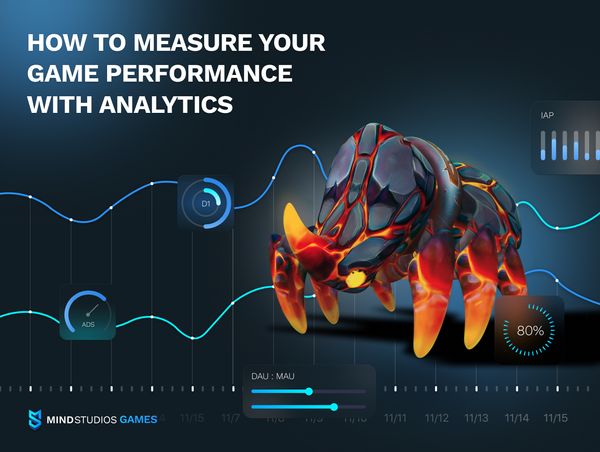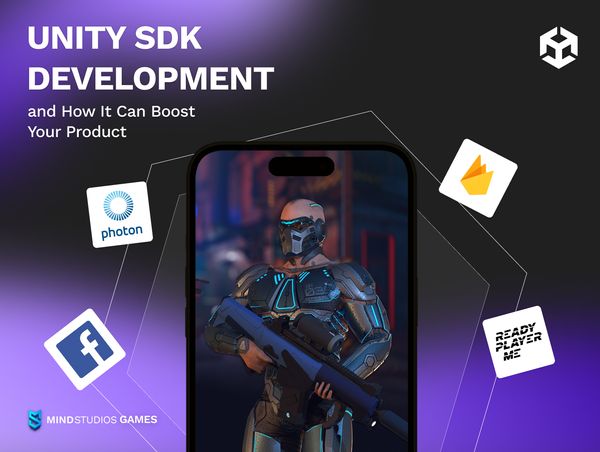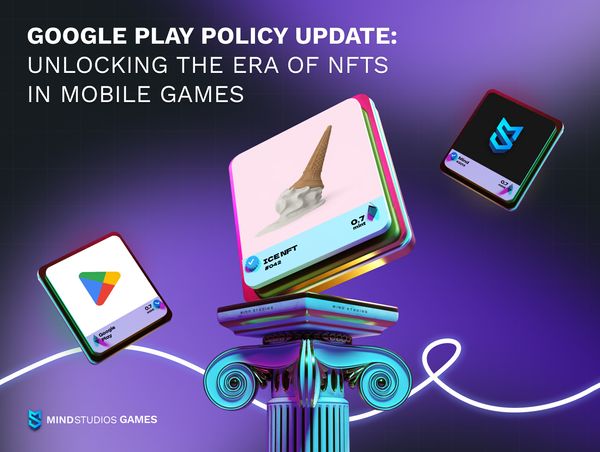If a game developer tells you that mobile game analytics aren’t important — run away. Yes, seriously.
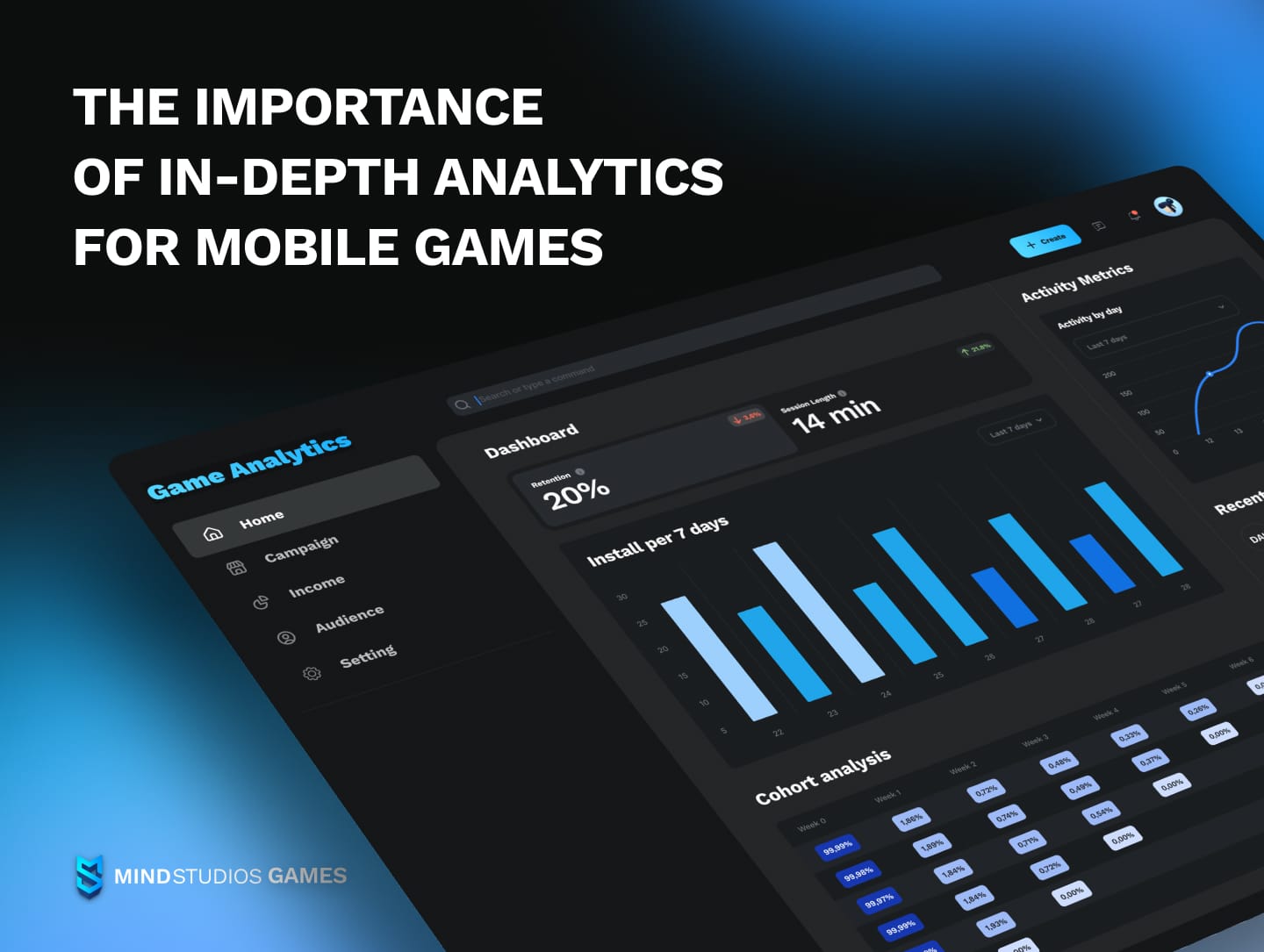
The mobile gaming market is expected to generate a revenue of $98.74 billion worldwide in 2024 and to show a compound annual growth rate (CAGR) of 6.39% in the next three years. That totals to a projected market volume of $118.90 billion by 2027.
However, there are millions of games in app stores and on digital game platforms. If you plan to join this market, you need a product that’s not only well-built, but also relevant and capable of withstanding the competition. That's where mobile gaming analytics step in.
Besides being adept at conventional analytics tools, Mind Studios Games also has our own analytics system for games. Which is why, we’re confident enough to be giving out advice on this topic. This article is the result of our years of work, and we hope you find it helpful. If you have any questions after reading this, or would like to participate in our game analytics project — drop us a line.
Key highlights:
- Mobile game analytics are important for marketing, user acquisition, and monetization
- Another field analytics in gamedev are used for is UX improvement
- Key metrics to track for financial performance evaluation include number of installs, retention, DAU/MAU, revenue per user, CPI
- For game developers, the most important metrics would be crash reports, load times, and heat maps
- Our clients can opt for our custom mobile game analytics solution, which has a Unity SDK for easy integration
Understanding mobile game analytics
Mobile game analytics is the process of collecting, analyzing, and understanding data from players. The main goal of it is to learn all the essential information about player behaviors, preferences, and how they interact with the game. This helps developers and publishers improve games and make the player experience better.
The scope of mobile game analytics covers the following key areas:
- Effectiveness of marketing campaigns
- Identification of the most valuable channels for player acquisition
- Trends in players' behavior and player engagement factors
- Monetization strategy analysis
- User experience analysis
How can mobile game data analytics help your product?

As we've mentioned above, gathering and analyzing data can help you make informed decisions. Such decisions, in turn, can help your title grow and succeed in the dynamic and competitive mobile gaming market.
Here's exactly how data analytics in the gaming industry can help you:
- Understanding player preferences and behaviors will allow you to offer more relevant and engaging game content to your target audience. It can also help you adjust game mechanics to make your title more enjoyable.
- Analytics for mobile games can help you with identifying your game’s target audience and the best channels to approach them. This will increase the efficiency of your marketing strategies — by helping you allocate resources efficiently. As a result, your marketing ROI will go up.
- You will be able to develop features and enhancements that entice users to return by researching the factors that affect player retention.
- It is easier to improve ways to boost in-app purchases and ad income by analyzing monetization tendencies.
Put simply, analytics gives you a clear view of what aspects of your game are effective and which ones are ineffective. That may include anything from marketing to monetization to mechanics. By using this data, you may increase your success chances and adjust your game to fit your target audience's changing needs.
Key metrics to track
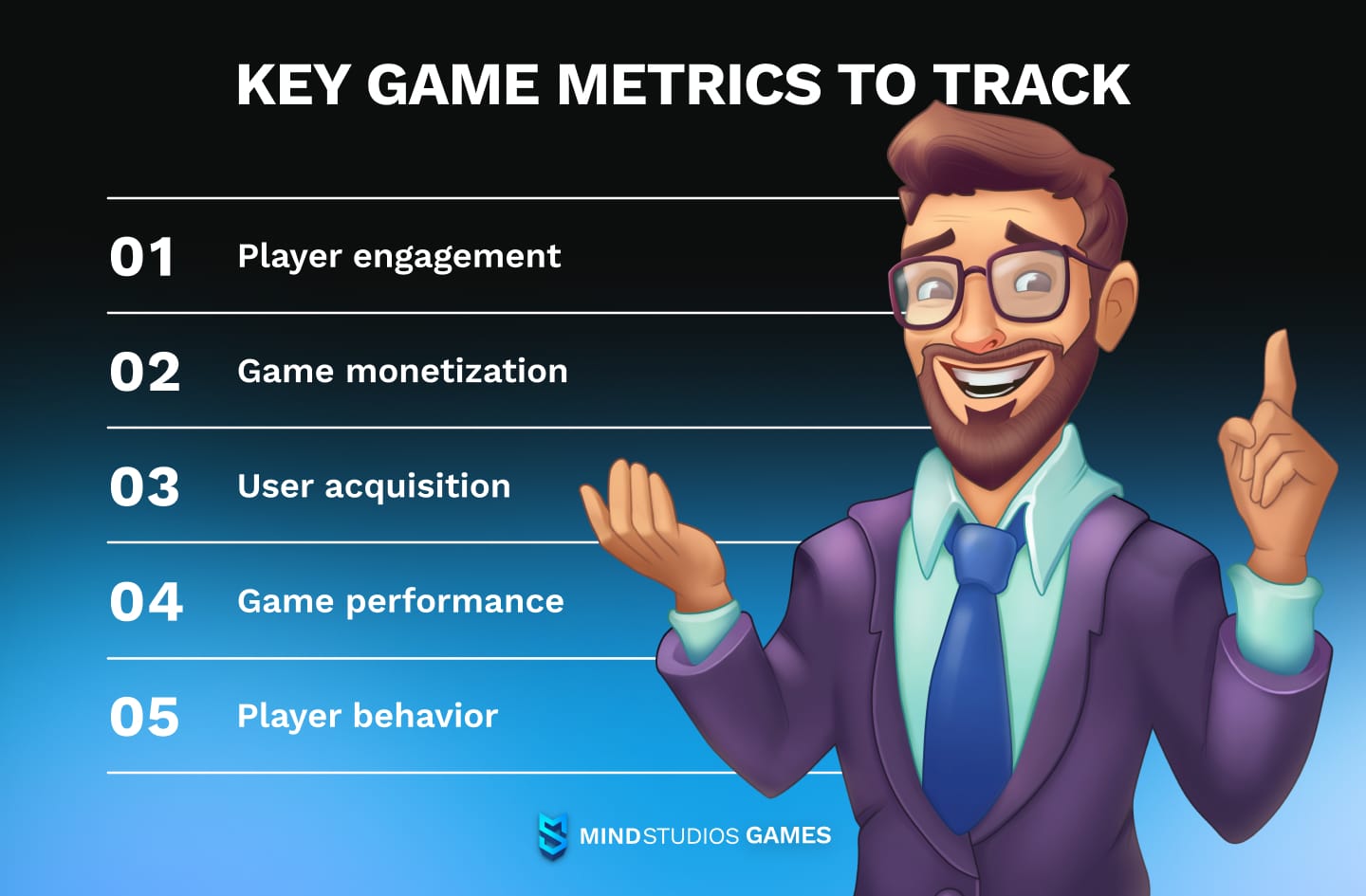
Now, which game analytics metrics should you track to get a comprehensive picture of your title's performance? While the amount of valuable data might seem overwhelming, here are some mobile gaming strategy tips we have. You’ll also find a link to a checklist to use later, at the end of this section.
The main parameters required for your game's success are the following.
Player engagement
This is a mobile game performance metric that basically shows how much your target audience likes your title. You succeed when players spend a lot of time enjoying your game and continue returning to it.
To track this, you need to focus on:
- Retention rate. This is the percentage of players who stick with the game over a certain period. The most popular points to measure are Day 1, Day 7, and Day 30.
- Session length. It shows how much time your players spend in your game per session.
- Daily Active Users (DAU) and Monthly Active Users (MAU). As the names suggest, these are the number of unique players who engage with your game per day and monthly.
Game monetization
Analyzing the effectiveness of a title's monetization helps you understand its profitability and figure out if it is worth the investment. You can do it by tracking the following mobile game metrics:
- Average Revenue Per User (ARPU): how much money a player brings you. You can determine the effectiveness of your monetization plan with the help of this metric. Do keep in mind that if you're using multiple channels for marketing, the statistics in this metric might differ for each channel.
- Lifetime Value (LTV): the total amount of revenue a player can bring in over their lifetime with your game, on average. This metric is handy when you need to figure out how much money you should invest in acquiring a user so that the business is profitable.
User acquisition
To grow and scale, you need to acquire new players as long as your game functions. To do this efficiently, you'll need to track the following mobile game performance metrics:
- Cost per install (CPI): most often, this metric is used when you launch digital ads to generate downloads. In this case, you'll be charged only when users follow the ad to install the app. You can determine whether the game does well on the market by tracking CPI. The average CPI of a mobile game in 2024 will range from $2.00 to $6.00 USD, depending on the operating system, country of release, and genre of the game.
- Number of organic installs: as the name suggests, this metric shows you how many installs your game had that weren’t a result of clicking an ad, but rather of searching for a game in the app store or via search engines. It’s a result of your app store optimization efforts.
- K-factor: a metric particularly favored by our Head of Gamedev, K-factor is the number that indicates how "viral" your game is — that is, how many people found it through recommendations and chose to install it. Word-of-mouth, social media sharing, and influencer marketing are some examples of this.
Game performance
Your game needs to run smoothly to keep players engaged and satisfied. You, in turn, can use the following metrics to track its performance:
- Crash reports: how often a game crashes and what causes it.
- Load times: how long it takes for the game to start and load levels.
- Frame rate: how smooth the game's graphics are. It is measured in frames per second (FPS).
Player behavior
These types of metrics allow you to understand player actions and experiences better and tailor the game experience accordingly. Maybe a certain level is too difficult to complete or simply too boring? Maybe a gameplay feature is difficult to comprehend? To figure such things out, monitor:
- Heat maps: they are basically visual representations that show where players spend the most time in the game; most useful for multiplayer game development.
- Progression metrics: they show how well players advance through the game levels or missions. If lots of players get stuck on the same level or mission, maybe it requires further adjustment.
- Feature usage: it allows you to figure out which game features players use most and least, and to a degree see if the game’s UX is effective.
These metrics are definitely not the only ones you can track. However, they are already a good start, as tracking these key metrics can help you make informed decisions to enhance gameplay, boost engagement, and increase revenue.
Here’s a downloadable shortened version of the metrics above, for your perusal
Best practices for utilizing analytics data
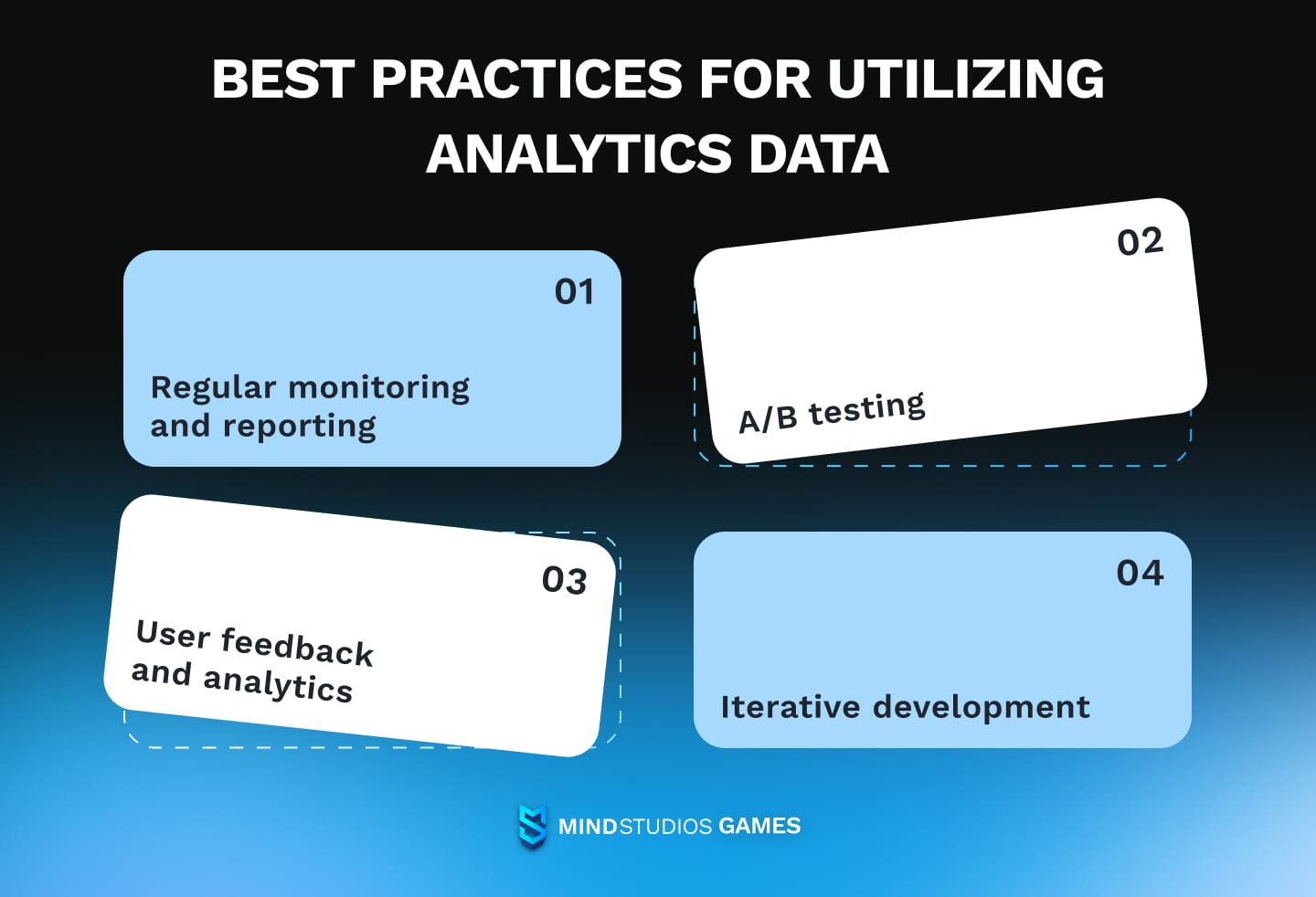
Picking the right metrics to track the efficiency of your title's performance is just half of the job. Another, no less important part, is to do it right.
We at Mind Studios welcome the data-driven approach and throughout the year have developed our own best practices for data analysis. Try following them before you come up with your own ones and see how it can improve the efficiency of data tracking processes.
Regular monitoring and reporting
One of the most crucial best practices to adhere to is consistency. To stay up to date on the performance of your game, you must constantly monitor and report on crucial data. After all, things might go from being important now to being irrelevant tomorrow, and vice versa.
Monitoring the metrics regularly enables you to identify trends and follow them, spot issues early, and fix them on time. To provide your team with up-to-date information, consider implementing dashboards and automated mobile gaming reports.
A/B testing
A/B testing is a highly effective tactic to compare different versions of your mobile game to see which one of them works better. This process can be more generic or more specific depending on your needs. You can test various game elements — for example, user interfaces, tutorials, or monetization strategies — to figure out how to improve your game's performance.
To make this process quicker and simpler, consider using A/B testing game analytics tools. You can also test variations with different segments of your player base to get more detailed and diverse insights.
User feedback and analytics
Your players can be one of the most informative and valuable sources of insights for your title. However, gathering user feedback shouldn't be an alternative to data analysis—instead, these two should go hand-in-hand to grant you a comprehensive understanding of player experiences.
While analytics provide quantitative insights, user feedback offers qualitative perspectives. Things like surveys, reviews, and direct feedback can complement your data-driven decisions.
To analyze user behavior effectively, segment your players by spending habits, skill level, or demographic information. This will help you customize the game for different player segments and create personalized experiences to boost player satisfaction and game retention.
Iterative development
An iterative development approach is all about continuously improving your game based on the most recent analytics insights. Analyze the data to come up with fresh ideas and regularly update your game with new features, enhancements, and fixes. Adopting this approach will help your game develop and evolve along with market trends and player preferences.
Mobile game analytics with Mind Studios Games
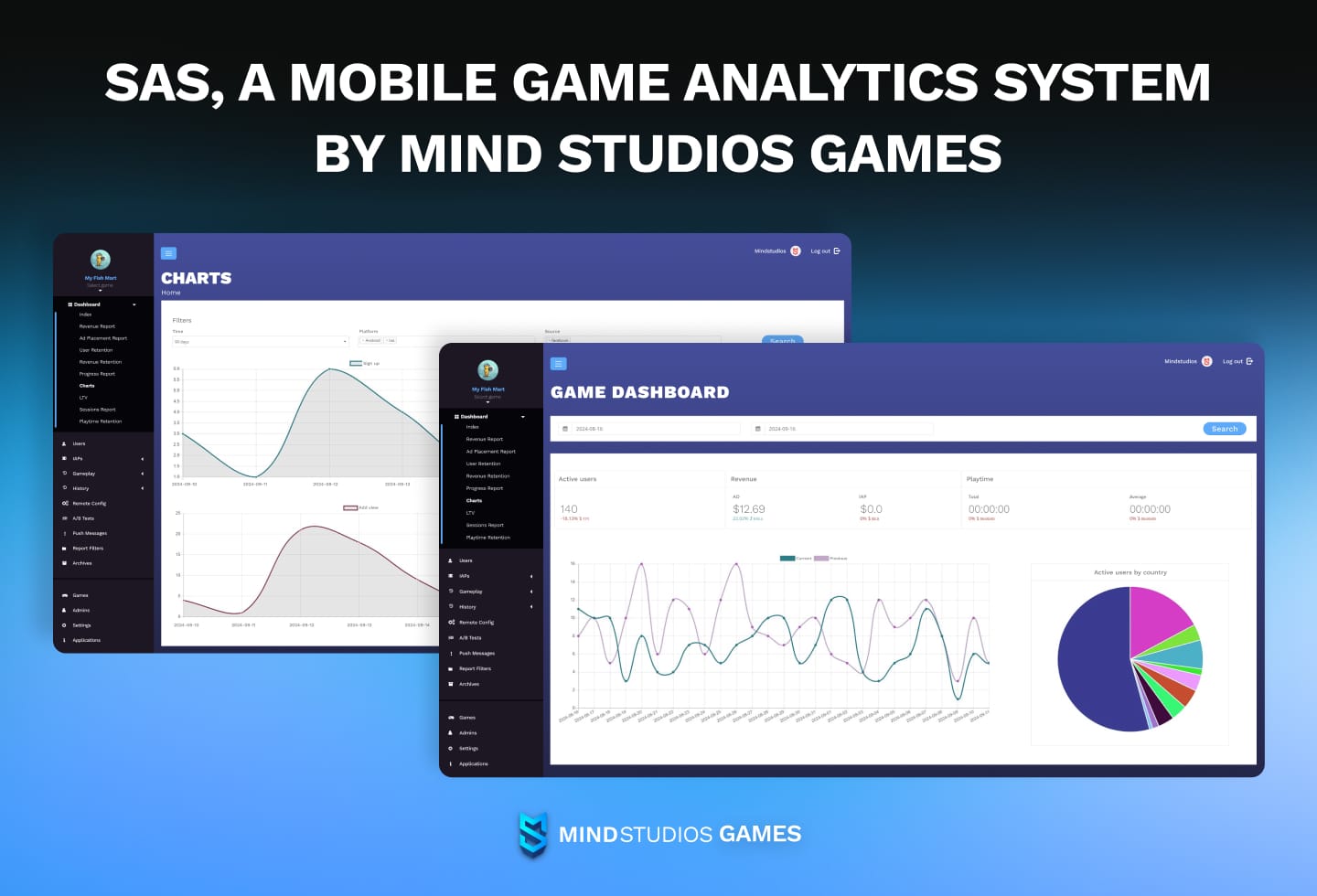
At Mind Studios Games, we have a custom proprietary analytics system that even some of our clients chose to use, although it’s still a work in progress. Here’s the story of how that happened, told by our senior backend developer, Dmytro:
When we started to develop our own games, we built a separate backend for each. Certain features essential for game functionality — e.g., authorization, push notifications, forced updates, IAP validation — were done through the server.
Later, we began gathering analytics data from our games, like the number of new users, number and amount of IAPs, etc. When adding the new analytics feature to one game, we had to manually add it to all others, which was a hassle. So we decided to build a system that connected all our games’ backends.
We called it SAS — Single Analytics System — and began adding analytics features there to collect and visualize data.
We have several clients we work with as an outsourced team, and when we told them what we do in regard to analytics in our games via SAS, they said they’d like to join the system with their projects. This prompted us to build a SAS Unity SDK to make the whole integration process easier.
Currently, several projects are using SAS and testing it, and we’re working on updates and upgrades.
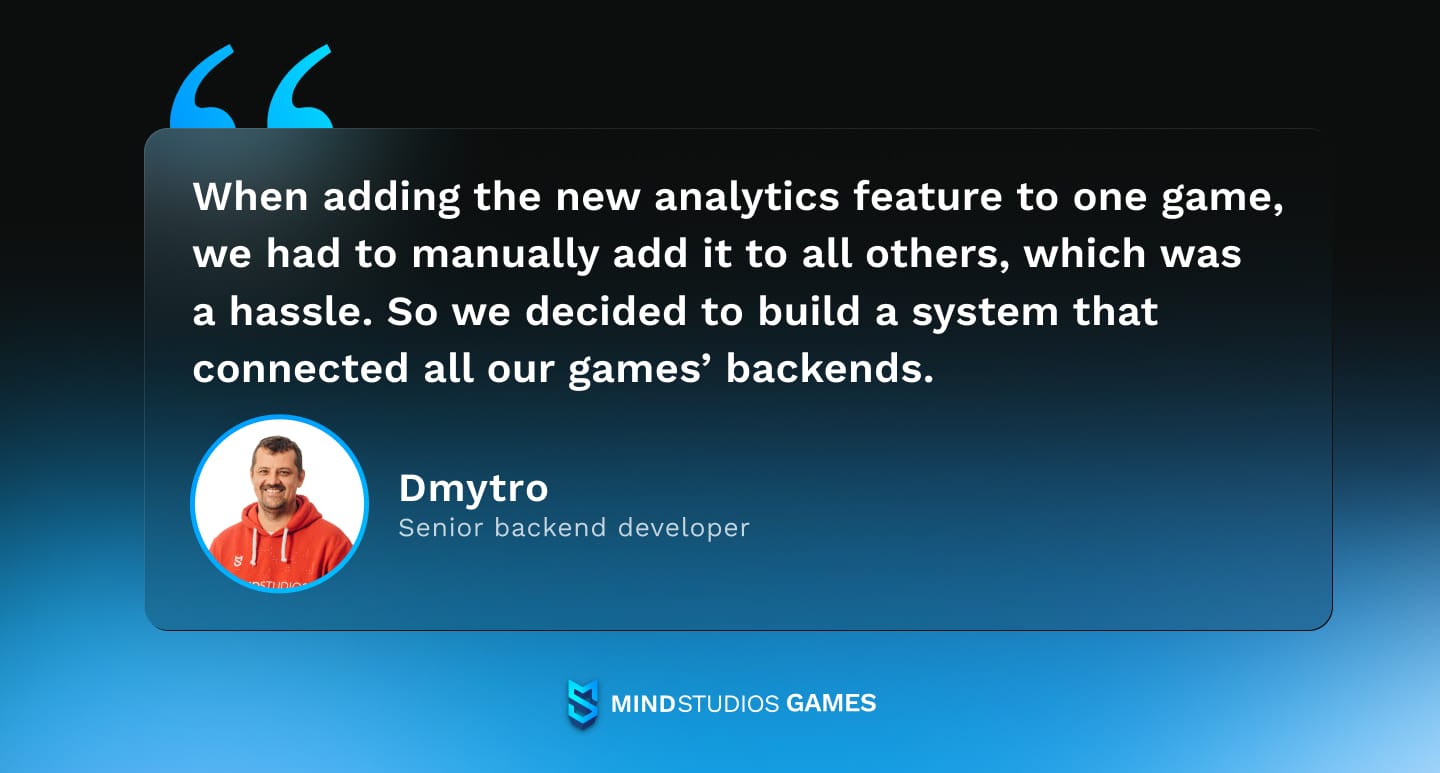
Conclusion
In the modern-day competitive mobile gaming industry, you need to work hard to help your title succeed. However, this process can become a bit easier if you start using in-depth analytics to understand player behavior, preferences, and trends. Doing so will allow you to optimize game design, enhance user experience, and increase profitability.
Throughout this article, we've explored the essential aspects of mobile game analytics, such as:
- Its definition and scope, which includes marketing effectiveness, player acquisition, engagement, monetization, and user experience
- Its benefits: using analytics allows you to tailor game content to the needs of your target audience, improve marketing strategies, boost player retention, and refine monetization approaches.
- Its key metrics that are important to track are player engagement, monetization, user acquisition, game performance, and player behavior.
- Best practices for mobile game analytics implementation: regular monitoring, A/B testing, combining user feedback with analytics, and iterative development.
In-depth analytics can help you create more engaging and profitable games in the rapidly growing and competitive market. Now is the time to start using an analytical approach to transform your game and achieve your business goals.

